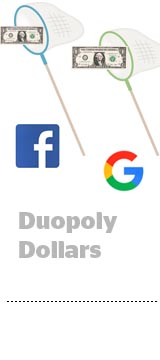
Digital advertising is growing, and big platforms like Google and Facebook continue to reap the profits.
That’s the insight from global ad spend forecasts released Sunday by GroupM, Zenith and Manga, which predict the industry will grow between 3.1% and 5.2% this year to as high as $535 billion, as reported by Magna. Advertising growth will be fueled by digital, which will grow between 11.5% and 13% in 2018 and account for half of global ad dollars by 2020.
“The transition to a digital-centric media world accelerates as digital ad sales continue to grow as fast – and often faster – than expected,” said, Vincent Letang, EVP of global market intelligence at Magna, in the report.
But digital’s growth – and therefore industry growth – will be fueled by the prosperity of Facebook and Google.
GroupM pegs Google and Facebook’s current share of global digital ad investment, excluding China, at 84%. Zenith said both platforms accounted for 96% of growth in global digital ad spend in 2017. And despite concerns about Facebook’s shrinking ad load, Magna said social media will grow by 37% this year, while video grows by 28% in the US.
“Brands need to learn to live with Facebook and Google,” said Jonathan Barnard, head of forecasting and Zenith. “They and their agencies need as strong a partnership with these two platforms as possible. We don’t see anything to challenge that at the moment.”
GroupM pointed to Amazon as a potential duopoly challenger, estimating its on-and-off-platform search and display advertising revenue in the single-digit billions. But since advertising isn’t Amazon’s core focus, its growth in the space won’t significantly impact Google and Facebook’s trajectory next year, Zenith’s Barnard said.
“Amazon hasn’t gone wholesale toward advertising at the moment,” he said. “But if it did, that would revolutionize the market.”
The duopoly’s influence lessens when advertisers look at total video spend, said Lyle Schwartz, managing partner at GroupM.
“The duopoly becomes part of a much larger ecosystem, and there’s much more competition in that marketplace than people think,” he said.
To continue growing their share of the market, Facebook and Google will have to prove they can offer quality, brand-safe content that competes with broadcast TV and OTT networks like Netflix and Amazon, said Ed Gaffney, director of implementation research at GroupM.
“They’ve got to prove that they can compete with short-form video in a long-form video world,” he said. “But they want TV money, and they want to prove they can perform like TV.”
Cost-Cutting Continues
Despite growth in the digital sector, clients across the CPG, auto, telecom and retail sectors will continue cutting ad spend in 2018. These big ad spenders are lagging behind the rest of the economy, Magna said.
In a qualitative survey of its largest clients, Zenith found that advertisers in these sectors expect no growth in their brand portfolios in 2018.
“From a brand growth point of view, this is the situation in which companies should be spending more rather than less [on advertising],” Barnard said. “But from a pragmatic accountant’s point of view, you can see why they’re finding it difficult to cut top-line revenues and increase marketing costs.”
As clients continue to cut costs, GroupM sees a revenue opportunity around below-the-line services like procuring and normalizing data, Schwartz said.
“[Clients are] all looking for efficiency and effectiveness,” he said. “Some of the efficiency and effectiveness may not return to the marketplace and may go to the bottom line.”
Although brands are spending less, they’re getting smarter about how they approach programmatic and in turn spending more money programmatically. GroupM estimates programmatic budgets represent 20% of US digital spend, excluding social platforms.
Keenly aware of supply chain issues like fraud and viewability, brands are embracing data and private marketplaces to make smarter and more effective programmatic buys. Zenith forecasts that display advertising will increase 14% in 2017, driven by programmatic budgets.
“We’re seeing a shift from the early days of programmatic where almost all deals were conducted on the open market,” Barnard said. “Now a lot of brands are using programmatic techniques for dealing directly with publishers.”
This post was syndicated from Ad Exchanger.

More Stories
Taboola and Otago Daily Times sign record renewal in ANZ
The Post celebrates two years with free access and special subscription offer
ThinkTV campaign tackles The TV Advertising Paradox head-on